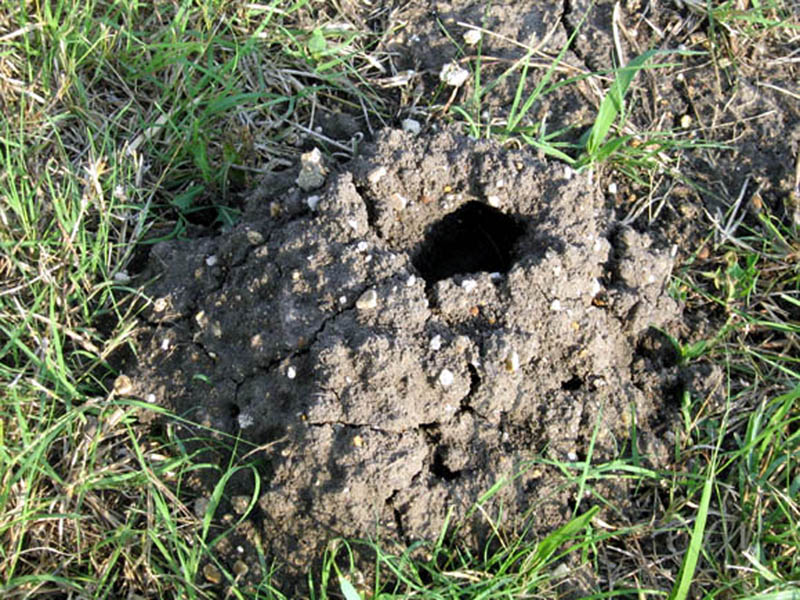What can be done about crayfish in lawns?
Crayfish are not a normal problem in lawns, but during extremely wet years, they just might become one of your lawns most important pests. Dr. Jim Parkhurst, Extension Wildlife Specialist at Virginia Tech, details the concerns and the strategies for dealing with crayfish and their accompanying ‘crayfish chimneys’ in the lawn.

We reach out to Dr. Jim Parkhurst, Associate Professor of Wildlife Science and Extension Wildlife Specialist in the Department of Fish and Wildlife Conservation for an answer.
In years of “normal” precipitation, my office might receive 1 or 2 requests a year about crayfish and associated lawn problems, but during very wet years, we are inundated with complaints from all across the state. As you might suspect, crayfish need saturated conditions to survive, so, where you have naturally-occurring high water tables, where people over-water their lawn and artificially raise the water table, or in years of exceptional rainfall, we see conditions that are favorable to and thus attract crayfish colonies.
The complaints we receive typically are not related to damage to vegetation, but to aesthetic concerns (i.e., the unsightly “chimneys” and soil mounds) and negative effects to lawn maintenance equipment (i.e., mowers being dulled after the blades hit these soils mounds). There actually is not much evidence in the scientific literature that crayfish cause significant damage to plants, as they tend to be detritus feeders and scavengers mostly, though some species are more carnivorous than herbivorous. So, we’re dealing primarily with people’s concern about appearance more than anything else.
The hard reality we face is that there is very little we can offer in terms of viable solutions. Currently, here in Virginia, there is nothing registered with EPA as a repellent or a toxicant for use on the broad array of crayfish species. Although some states have requested and received approval for an emergency 24(C) registration, no special registrations exist here in Virginia. Given that, there are no chemical treatments of any type we can discuss with clients. Social media and internet sources continue to mention a variety of ‘remedies,’ but they are illegal under our pesticide regulations as there are no labeled applications for such use. Additionally, there is an abundance of evidence showing that unauthorized use of such chemical ‘home remedy’ applications creates potential risk of impaired plant growth, contamination of local water sources, and secondary hazard exposure to other organisms.
The bottom line, therefore, is that we have very few tools left in the toolbox for crayfish control. Most of the extant research offers several suggestions or recommendations that many homeowners confronted with these critters are likely to find unacceptable, but it’s all we have. The first line of attack is to try to alter the hydrology of the site to promote dryer conditions. Because crayfish need saturated conditions near or slightly below the soil surface, lowering the water table or dispersing surface water to dry out the upper soil profile usually will make conditions less tolerable or less preferable for crayfish. In normal years, that might be a possible approach for consideration, but, in years with persistent heavy rains, it is not possible to draw down local surface water very effectively. When the rain stops, I anticipate the crayfish problems diminish.
The other approach is one that likely will provide only temporary relief if the site conditions described above are not changed. This is a trapping program. Crayfish can be baited and local population numbers can be reduced with a diligent trapping effort. Crayfish traps are available at a lot of outdoor recreation stores, but many of the designs are made for in-water application (i.e., more like a minnow trap) and will not work well on land. However, there are several designs that would be suitable for use in lawn applications. Trapping aficionados often recommend using decomposing fish, mashed sardines, or other putrid material as bait; others suggest moist cat food, wetted dog bones or kibbles, or similar materials. My concern is that, in many areas, these baits, though effective, also attract local cats, skunks, raccoons, and possums. Obviously, the openings on crayfish traps preclude those larger animals from getting in, but they still will try to knock the trap around to shake out the bait. Therefore, any traps placed in the field should be secured to the ground in a way that prevents them from being tipped, turned upside down, or dragged away. There are various lawn spikes and net staples that can serve as temporary anchors for this purpose. Traps need to be checked frequently as the first individuals captured easily can clean out the supply of bait in a short period of time, thereby reducing your capture potential; baits may need to be replaced or freshened regularly to enhance effectiveness. Any crayfish that are captured can be used as bait by fishers or, better yet, steamed and used for supper. I would not recommend doing so if there has been any history of prior chemical use in the area, as they likely will be carrying some load of such material.
Well, that’s about the extent of what we have to offer . . . not a very satisfying outcome for affected clients, I’m afraid, but that’s what we have to work with.


